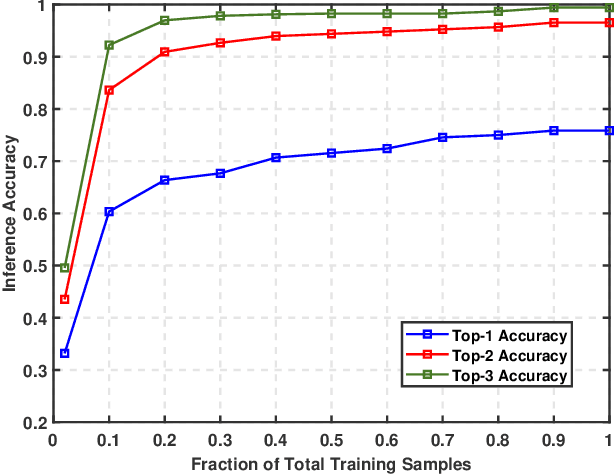Ngwe Thawdar
Joint Spatio-Temporal Precoding for Practical Non-Stationary Wireless Channels
Nov 11, 2022Abstract:The high mobility, density and multi-path evident in modern wireless systems makes the channel highly non-stationary. This causes temporal variation in the channel distribution that leads to the existence of time-varying joint interference across multiple degrees of freedom (DoF, e.g., users, antennas, frequency and symbols), which renders conventional precoding sub-optimal in practice. In this work, we derive a High-Order Generalization of Mercer's Theorem (HOGMT), which decomposes the multi-user non-stationary channel into two (dual) sets of jointly orthogonal subchannels (eigenfunctions), that result in the other set when one set is transmitted through the channel. This duality and joint orthogonality of eigenfuntions ensure transmission over independently flat-fading subchannels. Consequently, transmitting these eigenfunctions with optimally derived coefficients eventually mitigates any interference across its degrees of freedoms and forms the foundation of the proposed joint spatio-temporal precoding. The transferred dual eigenfuntions and coefficients directly reconstruct the data symbols at the receiver upon demodulation, thereby significantly reducing its computational burden, by alleviating the need for any complementary post-coding. Additionally, the eigenfunctions decomposed from the time-frequency delay-Doppler channel kernel are paramount to extracting the second-order channel statistics, and therefore completely characterize the underlying channel. We evaluate this using a realistic non-stationary channel framework built in Matlab and show that our precoding achieves ${\geqslant}$4 orders of reduction in BER at SNR${\geqslant}15$dB in OFDM systems for higher-order modulations and less complexity compared to the state-of-the-art precoding.
Unified Characterization and Precoding for Non-Stationary Channels
Feb 08, 2022
Abstract:Modern wireless channels are increasingly dense and mobile making the channel highly non-stationary. The time-varying distribution and the existence of joint interference across multiple degrees of freedom (e.g., users, antennas, frequency and symbols) in such channels render conventional precoding sub-optimal in practice, and have led to historically poor characterization of their statistics. The core of our work is the derivation of a high-order generalization of Mercer's Theorem to decompose the non-stationary channel into constituent fading sub-channels (2-D eigenfunctions) that are jointly orthogonal across its degrees of freedom. Consequently, transmitting these eigenfunctions with optimally derived coefficients eventually mitigates any interference across these dimensions and forms the foundation of the proposed joint spatio-temporal precoding. The precoded symbols directly reconstruct the data symbols at the receiver upon demodulation, thereby significantly reducing its computational burden, by alleviating the need for any complementary decoding. These eigenfunctions are paramount to extracting the second-order channel statistics, and therefore completely characterize the underlying channel. Theory and simulations show that such precoding leads to ${>}10^4{\times}$ BER improvement (at 20dB) over existing methods for non-stationary channels.
Proofs and Supplementary Material: Unified Characterization and Precoding for Non-Stationary Channels
Feb 03, 2022
Abstract:This document provides the supplementary material including a comprehensive related work, the complete proofs and extended evaluation results that support the manuscript, "Unified Characterization and Precoding for Non-Stationary Channels", that was accepted for publication at IEEE International Conference on Communications (ICC) 2022. Equations (1)--(34) refer to the equations from the main manuscript, and the Theorem, Lemma and Corollaries correspond to those from the manuscript.
Vision-Position Multi-Modal Beam Prediction Using Real Millimeter Wave Datasets
Nov 15, 2021



Abstract:Enabling highly-mobile millimeter wave (mmWave) and terahertz (THz) wireless communication applications requires overcoming the critical challenges associated with the large antenna arrays deployed at these systems. In particular, adjusting the narrow beams of these antenna arrays typically incurs high beam training overhead that scales with the number of antennas. To address these challenges, this paper proposes a multi-modal machine learning based approach that leverages positional and visual (camera) data collected from the wireless communication environment for fast beam prediction. The developed framework has been tested on a real-world vehicular dataset comprising practical GPS, camera, and mmWave beam training data. The results show the proposed approach achieves more than $\approx$ 75\% top-1 beam prediction accuracy and close to 100\% top-3 beam prediction accuracy in realistic communication scenarios.
 Add to Chrome
Add to Chrome Add to Firefox
Add to Firefox Add to Edge
Add to Edge